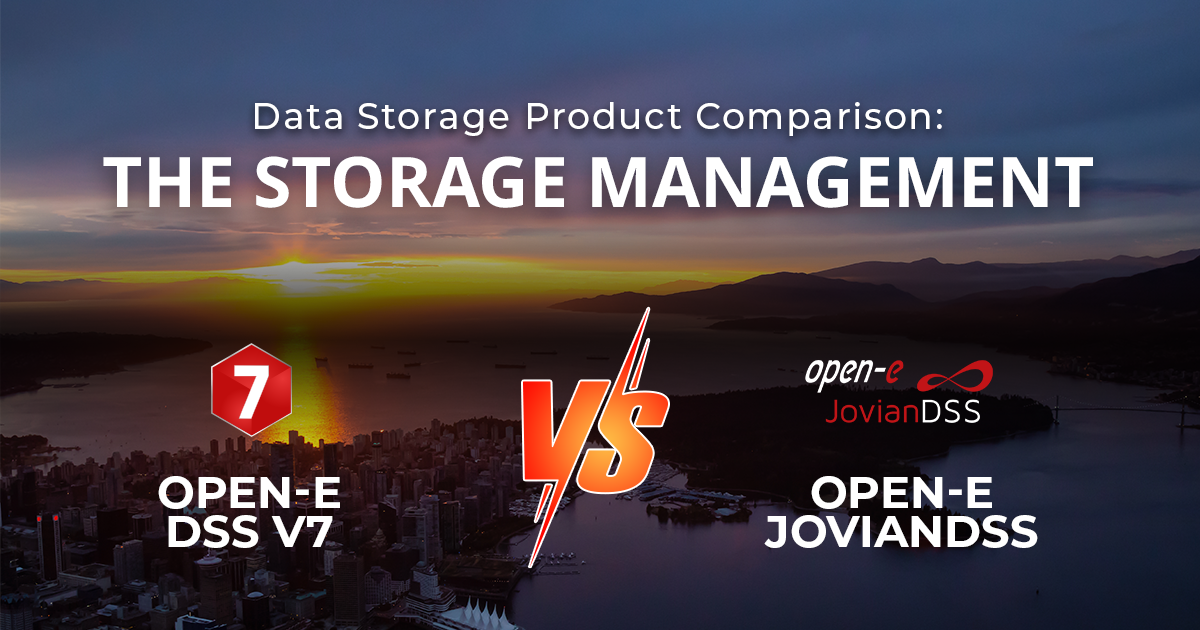Open-E DSS V7 vs Open-E JovianDSS - The Administration
A while ago, we presented you with a short Features Comparison Between Open-E JovianDSS and…
Read More
Open-E JovianDSS exceeds its predecessor on multiple levels, leaving it far behind. Moreover, the latest update of the Open-E flagship product, Open-E JovianDSS Up30, provides many improvements that make IT administrators’ work way more convenient and the infrastructure even more efficient. In today’s article, we’d like to show you
Open-E JovianDSS features related to the system’s core. So, without further ado, let’s see what our data storage software offers regarding Data Storage Management and Data Expanding Storage features that were missing in Open-E DSS V7!
In Open-E DSS V7, the system supported a maximum of 20 defined snapshots with only 10 active at a time, whereas Open-E JovianDSS significantly expanded this capability to accommodate hundreds of thousands of snapshots. Additionally, the system allows for the creation of multiple snapshots simultaneously per logical volume, providing extensive flexibility in data management and retention strategies.
Cloning a snapshot involves creating an exact writable copy of this snapshot, a fully independent volume that can be used for various purposes, such as testing, development, backup, or even as a new production volume. Developers can use clones to quickly create new instances of data volumes without copying the entire data set or create isolated environments for testing without affecting the production environment.
Open-E JovianDSS provides robust support for stored data encryption, ensuring the highest level of security for your data storage environment. This feature is particularly advantageous when utilizing Self-Encrypted Drives (SEDs), which automatically encrypt data written to the disks. Integrating with SEDs enhances data security by safeguarding sensitive information against unauthorized access, both at rest and during data transfer. By leveraging Open-E JovianDSS encryption capabilities, organizations can comply with stringent data protection regulations and standards while maintaining optimal performance and ease of management.
Read this article to learn more about SED and its utility for single-node and shared or non-shared storage cluster configurations!
Data deduplication and compression functions are also applied. They help you save a lot of storage space and improve the efficiency of your data storage by eliminating duplicates and shrinking the size of files. The older system requires you to move the data manually from one location to another and offers a limited number of snapshots.
Open-E JovianDSS supports Special Data Allocation Classes, which allow for storing ZFS metadata and small files on high-speed drives.
The Data Migration Tool in Open-E JovianDSS is designed to facilitate the seamless data transfer from Open-E DSS V7 to Open-E JovianDSS. This can be particularly useful during hardware upgrades, migrations to new data storage technologies, or rebalancing workloads across different data storage devices.
The tool is designed to minimize disruption to ongoing operations. This means that data migration can occur while the data storage system is still in use, ensuring that there is no significant downtime. This feature allows to perform incremental data transfers, meaning it initially migrates all existing data and subsequently only transfers changes made during the migration process. This reduces the time and bandwidth required for migration, especially for large datasets.
In addition, the tool performs consistency checks before, during, and after migration. This helps verify that data is accurately transferred without corruption or loss. Of course, the tool supports a variety of data storage protocols (such as iSCSI, Fibre Channel, NFS, SMB/CIFS), ensuring compatibility with different types of data storage systems and network configurations.
SSD-Trim is a command that allows the operating system to inform an SSD about data blocks that are no longer in use and can be wiped internally. This is crucial for SSDs because of how they manage data at the hardware level. SSDs write data to memory cells; over time, these cells may become cluttered with no longer needed data. Trim helps to clean up these cells, making the SSD’s garbage collection process more efficient and maintaining optimal performance.
Auto-Trim is a feature that automates the process of issuing Trim commands to the SSD. Instead of relying on manual Trim operations, Auto-Trim continuously sends trim commands as soon as the system determines that data blocks are no longer needed. This automated process ensures that the SSD always operates efficiently without requiring manual intervention. It helps to avoid the performance degradation that can occur if trim operations are delayed or overlooked.
The VMware ESX Auto Storage Rescan feature simplifies the management and utilization of data storage resources within VMware ESXi by automating the process of detecting new or modified data storage configurations.
When new data storage volumes are created, or existing ones are modified in Open-E JovianDSS, the VMware ESXi hosts need to recognize these changes to make them available. The Auto Storage Rescan feature ensures that ESXi hosts automatically rescan new data storage devices or changes in data storage configurations without manual intervention.
The Instant Pool Expansion option in Open-E JovianDSS enables seamless and immediate expansion of data storage pool capacity by integrating new disks into an existing pool without requiring system downtime. This feature simplifies the process of scaling data storage resources to meet growing data demands, ensuring that additional capacity is available as soon as the new disks are added. Administrators can quickly and efficiently increase data storage without disrupting ongoing operations, maintaining both system availability and performance. This capability is particularly valuable in dynamic environments where data requirements can change rapidly, providing flexibility and agility in data storage management.
Considering a switch from Open-E DSS V7 to Open-E JovianDSS? Contact your Open-E Sales Representative for a custom special offer, which includes:
For more details on the preferential terms for moving from Open-E DSS V7 to Open-E JovianDSS, consult our specialized brochure.
Leave a Reply